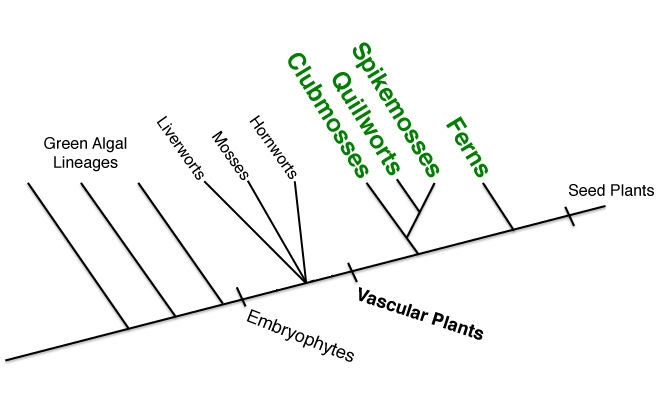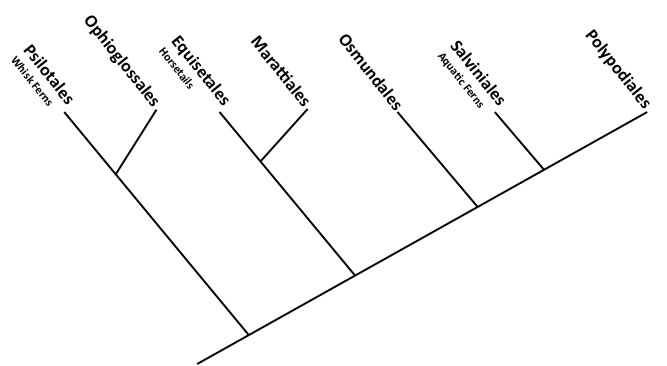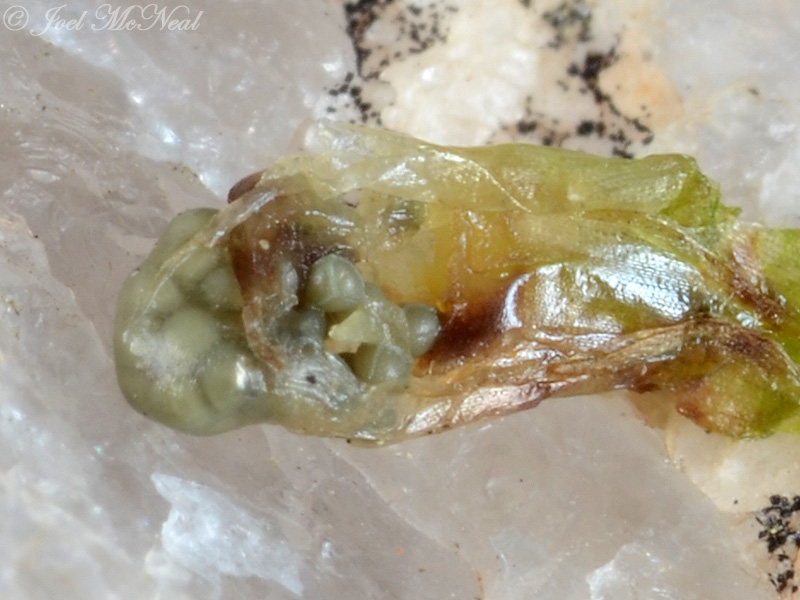Vascular Spore-producing plants (Vascular Cryptogams)

The earliest vascular plant fossils appear in the fossil record 420 million years ago. An obvious synapomorphy shared by all vascular plants is true vasculature- dead, hollow, water-conducting cells known as xylem and specialized living cells adapted for transport of sugars and amino acids known as phloem.
The vasculature is present only in the sporophyte generation and allows the sporophyte to grow much taller than the sporophytes of nonvascular plants. Vascularized roots and leaves are unique to these sporophytes, and the self-sufficient sporophyte generation is much longer-lived than the gametophyte generation in vascular plants.
Within vascular plants, the first branching lineage are the Lycophytes, a group that collectively consists of Clubmosses, Quillworts, and Spikemosses. The ferns (Pteridophytes) are more closely related to seed plants.
Clubmosses, Quillworts, and Spikemosses (Lycopodiophyta)
Lycopodiales (Clubmosses): 475 species
Although Clubmosses and Spikemosses can look superficially similar, Spikemosses are actually more closely related to Quillworts. While Spikemosses and Quillworts are heterosporous, Clubmosses are homosporous, producing only one type of spore that developes into a haploid gametophyte that is capable of producing both sperm and egg cells. In Clubmosses, this gametophyte may be either photosynthetic or a mycotrophic, nonphotosynthetic organism reliant upon nutrients drawn through a mycorrhizal fungus attached to photosynthetic organisms.
The sporophytes of clubmosses can produce their sporangia in the axils of normal leaves (see Huperziaspecies below) or produce them at the summit of their stems in strobili, with the sporangia shielded by scale-like leaves (see Diphasiastrum and Lycopodium below). Unlike spikemosses, these strobili are round in cross-section.
The spores of Clubmosses are coated in a combustible oil that keeps the spores insulated from water in humid air and allows them to travel further before germinating. The water-repellant quality of these oils formerly led to their use in lining latex items before talc was more readily available, and their easy combustion allowed them to be used to cut gunpowder and to produce bright flashes used in early flash photography.
Lycopodiaceae: Clubmoss Family
Isoetales (Quillworts): 90 species
Quillworts and Spikemosses share the characteristic of being heterosporous- both groups produce small microspores and larger megaspores. The male gametophyte develops entirely within the microspore, and eventually releases swimming sperm. The female gametophyte develops into a larger multicellular gametophyte within the megaspore that produces egg cells. When a sperm cell reaches one of these egg cells, the roots and leaves of the new diploid Quillwort that develops from the zygote quickly emerge from and outgrow the megaspore.
Quillworts morphologically resemble grasses (an alternate name for some species is Merlingrass) and appear quite distinct from Spikemosses and Clubmosses, but this morphology stems from an adaptation to their aquatic lifestyle. Like Spikemosses and Clubmosses, the sporangia are produced at the base of modified leaves in Quillworts.
Some quillworts live in the substrate of relatively permanent bodies of water like lakes and streams, but other common habitats to find them in Georgia are temporary pools in rock outcrops. These pools dessicate completely in summer heat, and the quillworts survive as dormant corms until the next period of prolonged submersion.
Isoetaceae: Quillwort Family
Black-spored Quillwort
Piedmont Quillwort
Selaginellales (Spikemosses): 400 species
Spikemosses often superficially resemble Clubmosses, but the cones of Spikemosses are square in cross-section. Indicative of their closer relationship to Quillworts, Spikemosses are also heterosporous, with short-lived gametophytes that develop largely or entirely within the spore wall. Both microspores and megaspores are produced within the same strobili, but only one type of sporangia is found under an individual scale. Spikemosses can be found in many habitats, from permanently wet seepages and streamsides to extremely hot, dry rock outcrops.
Selaginellaceae: Spikemoss Family
Ferns (Pteridophyta): 12,000 species
Ferns are a diverse group that includes some morphologically unfernlike lineages like Whisk Ferns and Horsetails, both of which use stems for photosynthesis in lieu of leaves, that are derived from more fernlike ancestors. Aquatic ferns range from plants rooted in the substrate like water clover to free-floating species. Most ferns are homosporous, but aquatic ferns have independently become heterosporous like Spikemosses and Quillworts.
Fern haploid gametophytes are also extremely variable, with most being small, thalloid, photosynthetic organisms. In some cases, the gametophytes can become quite large, whereas in other cases like Whisk Ferns and Ophioglossoid Ferns, the gametophytes may be mycotrophic and nonphotosynthetic like some Clubmosses. The heterosporous aquatic ferns produce gametophytes that don't outgrow the spore wall in similar fashion to Quillworts and Spikemosses.
Ferns are the closest living relatives of Seed Plants, and intermediate 'Seed Fern' taxa exist in the fossil record. Ferns are widely cultivated as ornamental plants, the fiddleheads of some ferns are cultivated as food, and tough blocks fiber from tropical tree ferns are widely used as support for cultivated epiphytes like orchids. Mosquito Fern (Azolla) is frequently spread among flooded rice fields because it harbors nitrogen-fixing bacteria useful for fertilizing the rice crop. Other ferns, like aquatic Salvinia and Water Clover, and terrestrial Japanese and Small-leaf Climbing-ferns, can become ecologically damaging invasives where introduced outside their native range.

Psilotales
Psilotaceae (Whisk Fern Family)
Whisk Fern
Ophioglossales
Ophioglossaceae (Adder's Tongue Family)
Equisetales
Equisetaceae (Horsetail Family)
Marattiales
Marattiaceae
Osmundales
Osmundaceae (Royal Fern Family)
Salviniales
Salviniaceae (Floating Fern Family)
Polypodiales
Pteridaceae (Table Fern Family)
Hairy Lipfern
Dennstaedtiaceae (Bracken Family)
Aspleniaceae (Spleenwort Family)
Walking Fern
Blechnaceae (Chain Fern Family)
Athyriaceae (Lady Fern Family)
Athyrium filix-femina
Dryopteridaceae (Wood Fern Family)
Goldie's Wood Fern
Polypodiaceae (Polypody Family)




















































































